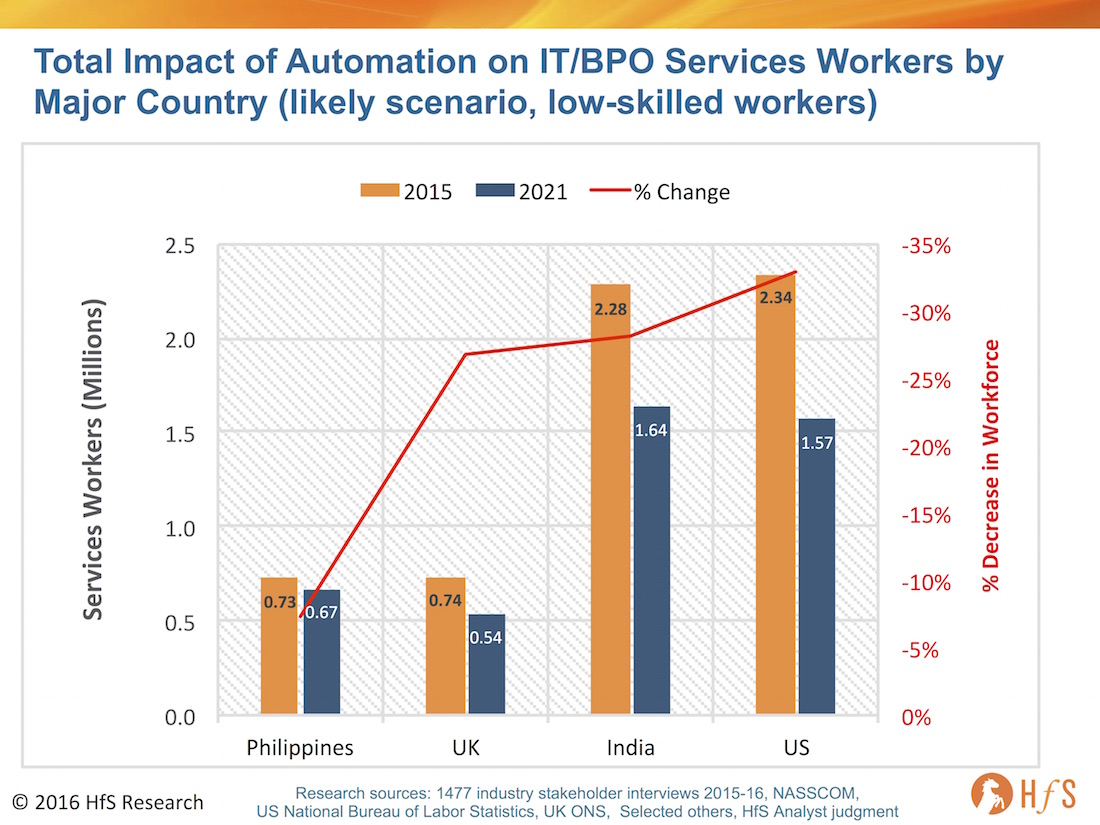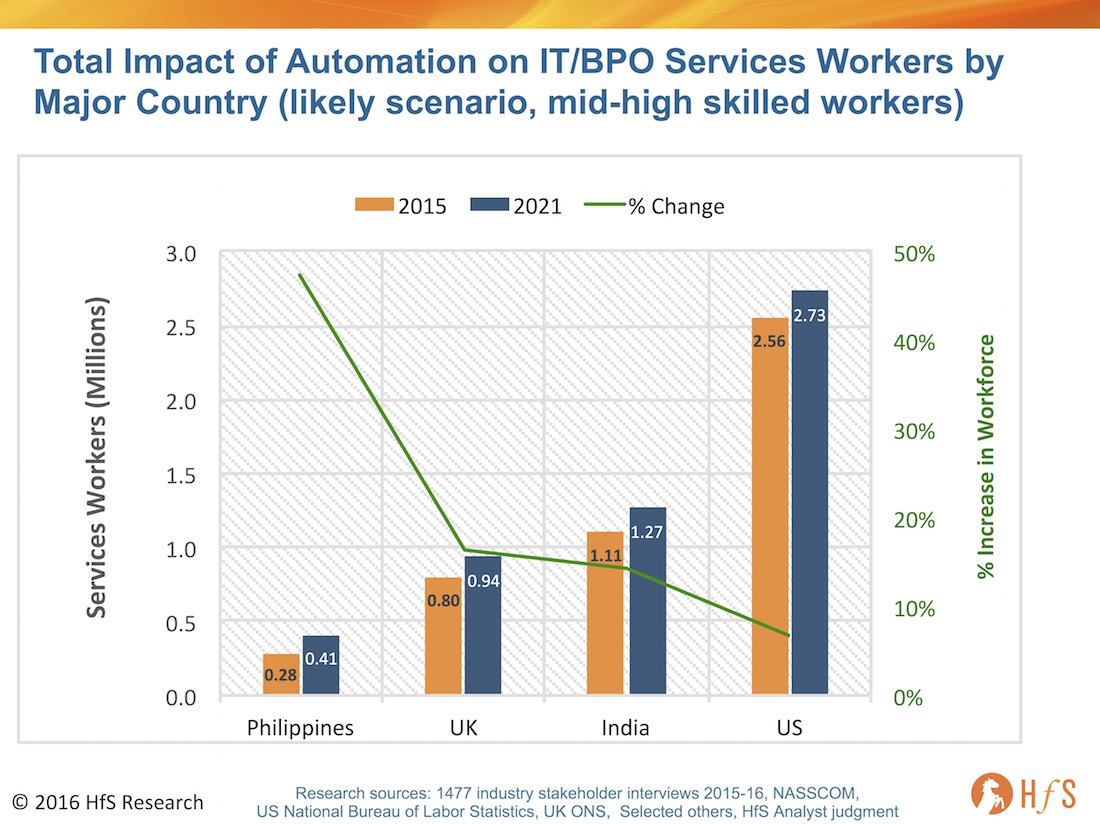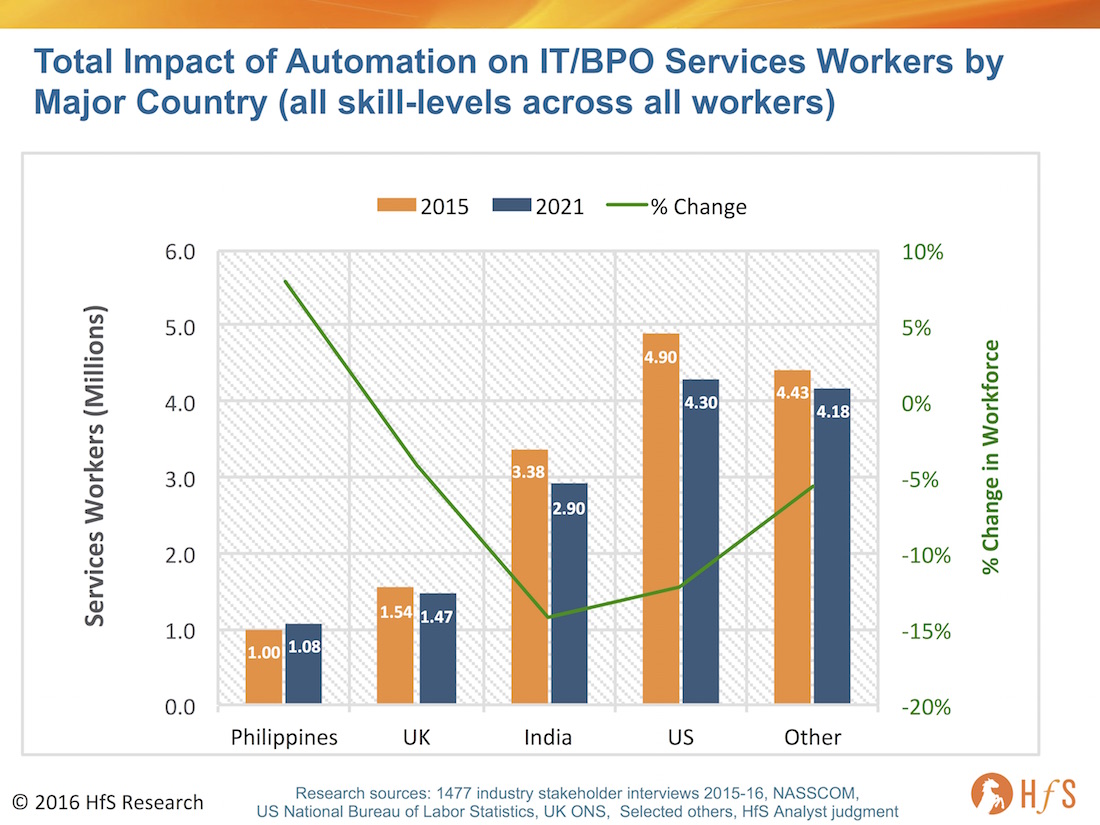Last week (see post) we revealed the true impact of the emergence of Intelligent Automation on the global industry of 15 million IT services and BPO workers, revealing a net decrease of 9% and ~1.4 million jobs.
The HfS future workforce impact model predicts the likely impact of the most recent wave of automation on the IT Services and BPO industry. We estimate that the current total IT Service and BPO industry employs c15 million in 2015, with ~3.5 million in India, ~1 million in Philippines, ~5 million in North America and ~4 million in Europe.
The workers within the worldwide industry have been divided into 3 categories: low skilled, medium skilled and high skilled. Low skilled workers conduct simple entry level, process driven tasks that require little abstract thinking or autonomy. Medium-to-High level workers undertake more complicated tasks that require experience, complex problem solving, ability to learn on-the-job and to work autonomously. The model then applies underlying growth rates for each category linked to market growth. Each scenario has a different set of parameters that will impact each level of worker setting out likely degree of automation for each group and the probability that the job will be automated and in what time frame this is likely to happen. You can read a fuller description of our methodology for our future workforce impact model here.
The low-skilled United States and Indian services workforces are most impacted
So what does this look like when we drill down to the country levels of the main global delivery locations: UK, US, India and Philippines? Let’s start with the low-skilled positions, greatest at risk from robotic process automation (RPA):
(Click to Enlarge)
As the graphic illustrates, India is set to lose 640,000 and the US 770,000 low-skilled positions by 2021 – these are decreases of 28% and 33% respectively. This is largely because there are a large number of non-customer facing roles at the low-skill level in these countries, when you take into account the amount of back office processing and IT support work that are likely to be automated and consolidated across a smaller number of workers. On the flip side, the Philippines is expected to be the least impacted, due to its heavy reliance on voice-based customer support and high-touch healthcare operations work undertaken – and the location’s reputation for low-cost, high-quality services. The UK has a very large customer service call center industry, in addition to IT and back office clerical processing work, which protects the impact somewhat, but we still expect the impact to be high at the low-skill end (200,000 jobs at 27% decrease), especially with uncertainly over Brexit expected to drive enterprises to source to alternative locations.
Philippines, UK and India set to benefit the most from medium/high skills job creation by 2021
The whole counter-argument to job losses caused by automation is the new work created in the future to focus on higher value work. In addition, most of the low-end skills jobs are not being created in any case, hence many workers will be challenged to migrate and evolve their skills to take on roles with higher degrees of complex problem solving, autonomy, creativity and emotional intelligence. Based on the make up of the workforces, education levels anticipated service delivery work, we expect the Philippines to make the move higher up the mid/high value skills value chain (48% growth, albeit from a low base), the UK creating 131,000 new services jobs at 16% growth, India 160,000 at 14% growth and the US lagging with 7% expected growth at 173,000 new jobs:
(Click to Enlarge)
So what impact is all this having on the overall likely scenario to these countries’ service delivery workforces?
Overall, India’s services industry set to endure the largest negative impact with a 14% decline in its workforce
With 640,000 low-skilled jobs at risk, only being offset by 160,000 mid-high skilled jobs being created, HfS’ model predicts a 14% decline for India:
(Click to Enlarge)
The US service industry is also expected to suffer a notable decline with 12% total workforce reduction, with the UK at a more modest decline of 4%. The Philippines is actually expected to increase overall by 8%.
The Bottom-line: The advantage will go to those nations investing in the next waves of opportunities, not those stubbornly resisting innovation and obsessively trying to protect legacy business models that won’t be around in another decade
The good news is that the impact of automation isn’t about to have the Armageddon impact many outlandish futurists have predicted. However, I am not going to sugar-coat the impact advances in both automation an digital technologies are having on workforces, which struggle to change with the times. Enterprises today, which need to expand their operations, are not always going to look at extra headcounts to do it – if they need more insurance clams processed, they will want to ensure they have a platform in place to scale for the extra work (whether inhouse of with their service partner). If they have greater IT infrastructure management needs, they will look to better cloud-based orchestration tools to manage them. Simply put, the services industry grew up through more enterprises out-tasking work that was largely conducted by people. Now, the onus is shifting to using only people for tasks that require human skills that cannot be replicated in a piece of software – and this trend is snowballing as more tools for RPA and autonomics management are being widely adopted by enterprises and service providers alike.
The service providers cannot mess around here – their very competitiveness is at stake and they have to adopt Intelligent Automation aggressively if they want to remain viable and competitive with ambitious clients. This is creating a serious, significant issue for governments of countries with a heavy reliance on its workers providing outsourcing services for Western enterprises. India has enjoyed hyper-growth in its services industry for over two decades now, and this is the first time a decline is now setting in, in terms of worker numbers. Its leading service providers will maintain high margins for several years to come, but their growth through linear employee scale addition is on the slide. Half a million workers to be re-employed elsewhere is a large number, not the mention where the armies of “freshers” leaving the colleges are going to go. And let’s not forget the low-skilled employees not willing/capable of learning new skills and new ways of working. Meanwhile, the focus on affordable, multi-lingual customer work has been a masterstroke for the Philippines government, while the UK similarly benefits from a robust call center economy – industries core to their strengths in numbers.
In short, India needs to focus on new avenues for services job creation where it has strength in numbers and strength in potential. Engineering services in a bright spot, and so is analytics, with their being such a proficiency for data and technology from its services talent. Moreover, India has a very strong competency for process and, believe it or not, automation capability. So why not become a leader in helping clients access better data from better automated processes? Yes, the next five years will be the painful ones for India as we go through this transition from people to technology-plus-people services, but the five after that could well be a different story as enterprise crave more human-centric skills at scale that can’t be fed into a software object recording or SaaS platform. These are challenging times ahead, but where there is change these is always opportunity – and the advantage will go to those nations investing in the next waves of opportunities, not those stubbornly resisting innovation and obsessively trying to protect legacy business models that won’t be around in another decade…
Posted in : Cognitive Computing, Robotic Process Automation, Sourcing Locations









Phil,
One of the paradoxes of progress in the computer age is that as work becomes more specialized in many cases also more susceptible to automation; Extrapolate this and this is going to be an issue at hand in 3-5 years from now. Human effort becoming redundant in areas where volume hiring takes place at one hand has a big business benefit of cutting costs, however at the same time it’s an issue as many hands would potentially remain without work. Per International federation of robotics-Robots will take over 1.5 million jobs in just next 2 years and this presents interesting problem to solve for talent function with business leaders around capacity and capability. Many skills required by human’s today, may not be needed in 5 years from now and hence, on what skills would training be more focused on in future for human’s to have some jobs to do requires a serious thought.
It’s not only the mundane and repetitive tasks that robots can do. Curiosity, creativity, imaginative behaviour, appreciative behaviour and emotional awareness are some key human skills that gives human’s edge over machines, however there are experiments on for robots to be skills at these level.
Future of work is a key issue across the planet with rise of robots.
Kanwal
Phil –
The Exam question for the Indian Services employers is .. Can they generate more higher value jobs to make this a net positive situation? Also can the Industry in India take advantage of this trend by making Intelligent Automation another big employment opportunity in itself?
Neeraj
This is an interesting paradox to have – as leaders would have to balance between the rising needs for automation and having skilled workforce to manage these automation including robots; It is time to review our education system as well – as the current set of graduates will be facing an uncertain future as far as their employability is concerned.
Srinivas Mysore
Very solid study and I suppose one of the first on that topic … Well done HfS! And on the low end job decrease surely it is a fantastic opportunity to accelerate transformation moving up the value chain!
MYPOV – we will lose more than this. 90% of all offshore jobs are non value added administrative roles, easily replaced by BOTs, AI and Cognitive….
Some valid points Phil, but I would question whether the job losses can simply be ascribed to automation.
Look at developments like self service, cloud platforms, intelligent document capture along with handwriting and voice recognition.
Just couple of years back Medical Transcription was huge business for companies in India and Philippines but with the development happening in healthcare technology things are quite different now.
Mrinal | https://www.linkedin.com/in/mrinalsingha
This throws up more questions perhaps…
For example, India/India located firms,
Nasscom wants to believe a consistent 12 – 14% annual business growth is still likely, going by the usual predictions in recent years for the industry revenues. If you look at some intrapolation of the people numbers (guesstimates)and the current state of automation (automation directly linked to revenues as a percentage of total revenues) does it all add up? There will be hiccups along this journey to adopt automation, revenues got to be shrinking soon but are they projected to?
Another question, What are the significant challenges to be sorted during this shift from ‘people to technology (first) plus people’ transformation? Obviously, those mid level, highly skilled managers that they lack is a crucially important factor, what about the SaaS platforms/products/tools based delivery experience, the availability (or lack of) of management and middle layer that has deep knowledge of intelligent automation (some of these firms/countries have traditionally been followers), so that must be a big concern too?
Finally, forget RPA tools and new process automation solutions for a bit, just looking at the recent years of growth of platforms like Workday, SFDC, Similar..or even the cloud based services – where are the lions share of higher order skills and domain consultants for those located today?
Thanks,
I agree to an extent. RPA would change the way services are offered, but RPA are human made artificial intelligence. May be the focus would shift from physically run services to monitor the intelligence of the machines. Human hands would now be around creating / maintaining / monitoring these Robots. Therefore do not think human jobs would be completely eliminated.
I see other way round – is it losing 640K or making 640K automation experts? it is left to the professional to move into automation technologies. In order to make automation work, we need people to automate . I am seeing this change in professionals to automation from last 6 yrs !..
Phil,
Over last 16 years a lot of these jobs aren’t as remunerative as they were originally. Also, these jobs were adding some skill and exposure in those days. Now every kid comes out with decent computer education. I would say a blessing in disguise, this will help young graduates to think creatively rather than get comfortable into a no brainer… one creative idea may generate more jobs for others
Hitendera
Well, I am presently Into robotic automation and after taking a bigger view, I strongly feel that any estimated impact by automation lesser than 25% is actually misleading and can be a margin of error. Because automation will reduce people but at the same
Time creates more opportunities to increase usage and grow business go to new areas and spaces etc hence the base itself will grow tremendously. At the same time robotic implementation as such will need lot of hands and brains to develop it fully for next twenty years (same like IT Which otherwise supposed to be equally one time activity of implementing software globally for everything (barring maintanance activity) but that one time itself been an industry for fifty years or more). Added to this is whole concept of people’s time being spent less on transactional activity but more on planning, execution, better customer service and improved quality. Hence anything less than 25% of impact can not be said with certainty.
Robots replacing human is not something new. It has happened before will continue to happen in future. Example : Power looms replaced generations of weavers, Banking software replaced thousands of clerks and many more such examples. In all this, role of governments is critical. And governments’ reaction could be different from country to country – Depending on political structure, economic conditions and socialist vs capitalist mindsets. Case in point – Indian state of Tamil Nadu has now allowed IT workers to form unions – http://timesofindia.indiatimes.com/business/india-business/Techies-can-form-unions-at-workplace-Tamil-Nadu-government/articleshow/52664642.cms
@Pravin – when manual jobs were automated / modernized away many of those workers moved to white collar jobs, with the advents of computers, call centers, the internet etc. With lower endjobs in the white collar industry now under threat, the next “work” requires more mental application, smarter education, companies with goals greater than just making profits. Having major unemployment increases will only exacerbate the agitated working classes that we have today and fuel greater “have versus have not” divides in society. 2008 epitomised everything wrong with our financial and banking system… 2016 is he start of an ongoing political crisis where many “have not” people are just fed up with politicians who do not appear to “understand” them. People want career, then want jobs, they want wealth… take that away and we have political crises on our hands, potentially worse than we have ever seen with the rise of terrorism and nationalism. Automating away lowe-end white collar jobs is just a small contributor to what could potentially become a major societal problem…
PF
India has already a major challenge of unemployment and is addressing it with the Indian government coming out with PMKVY and other such programs. Government agencies along with private service providers and industry are working on developing skills and employing these people – with this data the challenge for the government would further increase – yes Indian BPO should leverage this automation and up skill their low skilled voice process agents so that maximum number of people would not end up loosing their job.